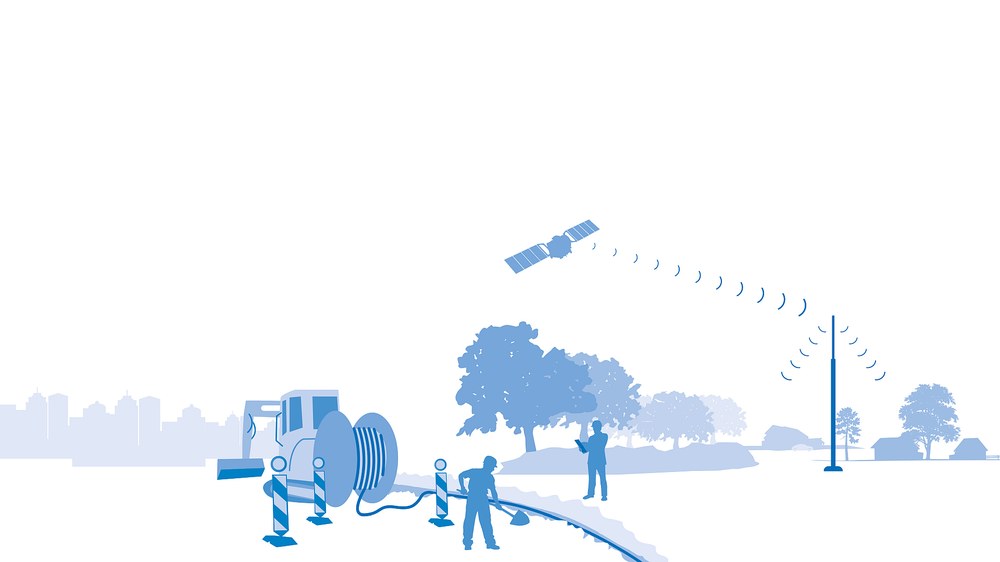An incubator for the information society


- The seventh National Conference on Satellite Communications in Germany, organised by the German Space Agency at DLR, will take place on 18 May 2021 and is being held virtually for the first time.
- Around 300 participants from the fields of research, industry, government and administration will come together to discuss the opportunities and challenges in this sector under the motto '#digital #networked #crisis-proof'.
- Discussions will centre around the themes of the EU Connectivity Strategy: broadband provision, 5G, the Internet of Things, and secure communication using quantum encryption.
- Focus: Space, digitalisation, broadband expansion, 5G, sustainability, start-ups
Everything is digitally networked
Our world is extremely networked. This is apparent both in our day-to-day lives as individuals and in the world of work. Everyone from manufacturers to service providers, goods transporters and application developers have customers and providers that are connected by an invisible digital link. "Fibre optics and mobile communications alone will not be enough throughout Germany to connect everyone and everything to a fast network," says Thomas Jarzombek, a member of the German Federal Parliament and the Federal Government Coordinator of German Aerospace Policy. "Satellite communications can help close this gap. This makes it a future market for the German space industry and for start-ups. With laser technology and quantum communications, Germany is a technology leader here." On 18 May 2021, Jarzombek will open the seventh National Conference on Satellite Communications in Germany under the motto '#digital #networked #crisis-proof', alongside Walther Pelzer, a Member of the DLR Executive Board and Head of the German Space Agency at DLR.
Connectivity at the top of the agenda
The EU Commission in Brussels is also aware of the growing importance of satellite communications. Thierry Breton, EU Commissioner for Internal Market with extended responsibility for defence and space, is promoting the EU Connectivity Strategy with this in mind. The potential fields of application being addressed by the Commission are diverse – from 5G broadband coverage to the Internet of Things, secure official communications and the exchange of quantum keys. "We want to help shape this initiative and actively set its priorities," says Pelzer. "For example, we envision the public sector as an anchor customer and want to include the creativity and innovative power of SMEs in the conception of the initiative. The COVID-19 pandemic has shown that the best solutions do not necessarily always come from large, established companies. As the German Space Agency at DLR, we will work to ensure that start-ups and SMEs also have direct access to the future market for satellite communications."
Using satellites to close gaps in broadband and 5G coverage – and beyond
According to the latest broadband atlas compiled by the Federal Ministry for Transport and Digital Infrastructure (BMVI), 58.3 percent of rural German households currently have a download speed of 100 megabits per second or more. A well-developed, robust network is essential for our modern day-to-day lives, not least as a result of the increasing nationwide adoption of teleworking. The expansion of high-performance networks is also slowed by limited civil engineering capacity. "Space can offer some assistance in this area," says Walther Pelzer. "Technological progress in satellite communications is laying the foundation for supplying unprovided or underserved households and communities with data rates of up to 100 megabits per second for downloads and six megabits per second for uploads. The German Space Agency at DLR has launched the DORF.digital (digital village) initiative with a view to moving this forward." The project is being implemented in partnership with Eutelsat and Airbus. A central receiving station in a small village in North Rhine-Westphalia forwards received data to the participating households via a wireless local area network in order to supply users with a fast internet connection. Yet broadband internet via satellite is not exclusive to this digital village. An unobstructed view to the south, a television-type dish antenna and a special transmitter and receiver module with a modem are all that is needed to access an internet connection supported by satellites in Germany. In future, mobile phone networks could also be expanded in a similar way as 5G and subsequent generations of mobile phone communications depend on the existence of global area coverage that is available at all times. Radio masts on the ground are not enough by themselves. Satellite technology can help to cover white spots on the map of mobile communications coverage.
Secure communications with quantum encryption
Communications between satellites using lasers is becoming ever more important for the increasingly networked satellite systems in low-Earth orbit at altitudes of between 300 and 3000 kilometres. Only laser links are capable of efficiently handling the rapidly growing quantities of data transmitted in space. However, no matter how fast and efficient a means of communication may be, it is only valuable if it is secure against eavesdropping attempts. Quantum technology will play a major role here. Quanta are the smallest indivisible units of energy and cannot pass from one state to another without leaving traces if they have been intercepted. This makes light quanta the ideal medium for securing large quantities of data via quantum encryption and ensuring that our data remains secure even in the age of quantum computers that can quickly defeat conventional encryption. Until now, however, it has only been possible to exchange the quantum keys that the authorised parties need to access the data over relatively short distances on Earth. If laser communications of the kind used in space applications can be utilised here, however, these secure keys could be transmitted over intercontinental distances. The German Space Agency at DLR is promoting the development of this technology through projects both within the country and as part of Germany's contributions to the European Space Agency (ESA) and the European Union. These endeavours include the ESA 'Security And cryptoGrAphic mission' (SAGA) project and the EU EuroQCI project, which focus on the development of a European quantum communications infrastructure.

